|
|
|
Jewels of medieval Switzerland
The summer has not only been slow to come but also fast to go. I
had hardly uploaded the last Bimonthly on the theme of
"summer explosion" when the summer did explode.
Three weeks of brilliant hot summer weather, then the big crunch.
Summer withdrew as suddenly as it had come and left us with
an unusually cool and rainy month of August. The kind of wishy-washy summer
nobody likes to have for their vacation.
Ideal
weather for working, then, but alas! It should not be. For a
number of reasons with which I am not going to bore you, there
was little opportunity for doing some sustained academic writing.
So I didn't. Those waiting for the continuation of the "Reflections
on reflective practice" series will have to wait a little
longer, I fear, as some other academic commitments have priority.
I intend to return to this major topic of current interest to
me soon.
During
those not so frequent summer days of the past two months
and the current nice late-summer days I did find some opportunities though
to go hiking and undertake
excursions nearby, to the mountains, lakes, and countryside
of the Canton Bern and of our neighboring Cantons Fribourg and
Lucerne. One of the things that keep surprising me is the
plenty of lovely country towns that can be found in these three
cantons, as well as in other areas of the country, to be sure.
They often have a remarkably medieval character, rivaling with
the medieval old towns of better-known Swiss cities such as
Bern, Geneva, and Lucerne. I am thinking, for example, of smaller
cities or country towns such as Fribourg, Murten, Nyon, Schaffhausen,
St. Gallen, Thun, Wil, or Zug, but also of picturesque
villages such as Aarberg, Avenches, Gruyères, Ligerz,
Morcote, St-Ursanne, Stein am Rhein, Willisau, and many others.
In a new series of occasional Bimonthlies, I would like
to offer some personal impressions of such jewels of medieval
Switzerland.
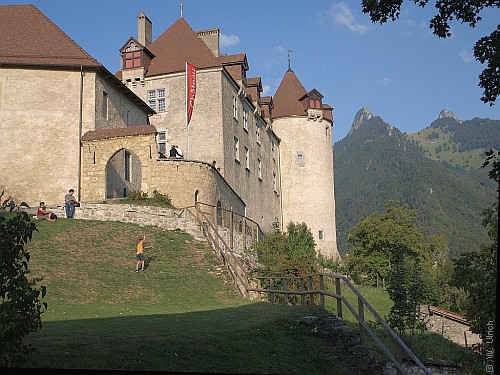
Hallmark
of the Pays de Gruyère: the castle
Le Pays de Gruyère You
may know the name from the excellent hard cheese to which the
small town of Gruyères – Greyerz in German – gives its
name; but the cheese is not the region's only jewel. Situated
some 40 kilometers northeast of Lake Geneva in the
French speaking part of the Canton of Fribourg, the scenery of the Pays de Gruyère (the
district of Gruyère)
is exceptionally beautiful. You will find here a gently
rolling landscape of green hills with Mount Moléson (2002m
above sea level) and other Alpine peaks in the backbround
and with lush green meadows in the foreground, full of
the famous black and white Fribourg cattle that gives the milk
for the cheese and other specialities of the region such as
the Fondue Moité-Moité and the Crème de Gruyère,
a fresh double cream that serves as a natural (and tasty) whipped
cream (e.g., for the famous Meringues of Gruyère) without
ever needing to be whipped. The area's center is Bulle, a lively
market town located close to the southern end of the Lac
de la Gruyère. But the area's jewel is undoubtedly the historical
town
of Gruyères, situated on a steep hill some five kilometers southeast
of Bulle at the feet of the castle, the Château de Gruyères.
 The
castle of Gruyères – origin and name
The
castle was built in the years 1270-1280 by the Counts of Gruyères,
whose unknown origin goes back to around 1000 or earlier and who ruled over the
area for some six hundred years, from the 11th to the 16th century.
They probably got their name from the Roman designation "grand-gruyer"
for the administrator of the forest and waters of the area,
whence also the name la gruerie for the municipality. The
Latin word grus, gruis, f., means crane (=
grue in French), which explains the heraldic emblem of
the medieval counts and contemporary municipality of Gruyères. The
castle of Gruyères – origin and name
The
castle was built in the years 1270-1280 by the Counts of Gruyères,
whose unknown origin goes back to around 1000 or earlier and who ruled over the
area for some six hundred years, from the 11th to the 16th century.
They probably got their name from the Roman designation "grand-gruyer"
for the administrator of the forest and waters of the area,
whence also the name la gruerie for the municipality. The
Latin word grus, gruis, f., means crane (=
grue in French), which explains the heraldic emblem of
the medieval counts and contemporary municipality of Gruyères.
You
may have noted a certain inconsistency of the use of the name
Gruyère(s) in plural vs. singular form. Briefly, the rule is
as follows:
- the
singular masculine form refers to the cheese – le
Gruyère;
- the
singular feminine form refers to the region – la
Gruyère (also: le Pays de la Gruyère, or more popularly,
le Pays de Gruyère); and
- the
plural fom refers to the town, the castle, and the noble
family that once owned it – Gruyères, and thus
also the castle of Gruyères and the counts de
Gruyères.
The
castle is now Switzerland's second most visited one, after the
Castle of Chillon near Montreux at Lake Geneva. It was partly
rebuilt in the 15th century and since 1938 has been a public museum
owned by the Canton of Fribourg. If you want to avoid the
crowds, don't visit it in July or August but prefer June or
September and October if you can – the latter two months are
probably the best season not only for visiting the castle and
town of Gruyères but also for hiking in the beautiful region. Thus prepared,
you are now ready to explore the town.
The historical
town of Gruyères It is actually a village rather than a town, with a permanent
population of currently some 1,800 inhabitants. It has just
two rows of – beautifully maintained and decorated –
houses,
built mostly in the 15th, 16th and 17th centuries, that
crawl up the hill from the lower village entry towards the former
chapel Le Calvaire (now an art gallery) in the middle
and on to the castle at the upper end. Apart from a small side street
that leads to the church somewhat outside and below the village
(the Rue de l'Eglise), these two rows of houses form
the town's only street, the Rue du Bourg, which then,
after entering the castle gate, becomes the Rue du Château.
A tiny little town indeed, but if one is to believe the tourist guides,
its picture-book medieval setting has
earned it the unofficial title of Europe's most picturesque
village. Here is what you see when you first enter the village,
after a short walk up the hill:
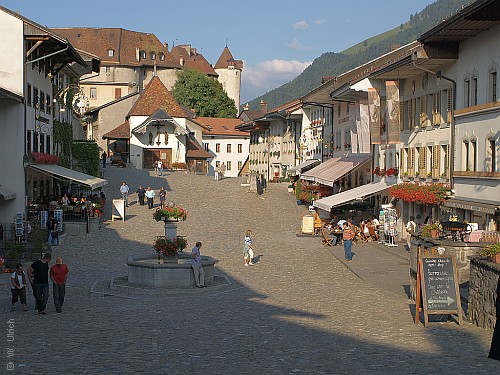
Entering
the historical town of Gruyères
And
here is what you see, in the back light of a September
afternoon,
if you walk till the fountain in the middle ground, sit down
in one of the street cafés, and then
look back to where you've come from:
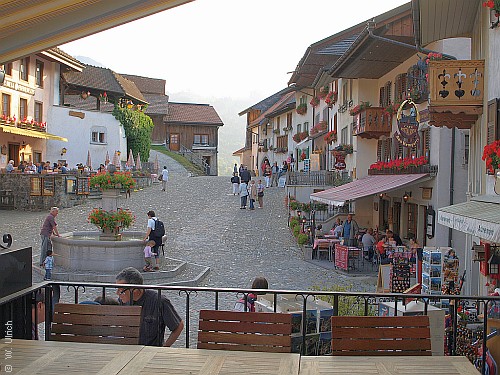
Looking
backwards to the village entry from one of the many street cafés
Sit
down, relax, and enjoy this characteristic village scene:
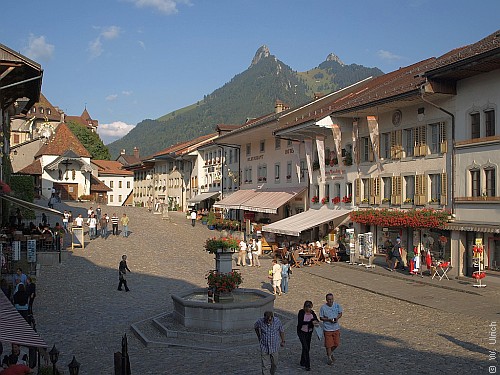
Characteristic
village scene
One
of the things you will note when you walk around is probably
the many magnificent escutcheons that traditionally decorate
restaurants, hotels, and shops:
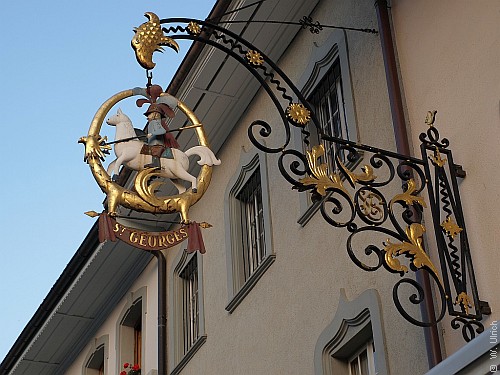
One
of many hanging
emblems
When
you continue your walk towards the castle, you will approach
Le Calvaire, the former chapel where the Rue de l'Eglise departs
to the right whereas the Rue du Bourg continues on the
left. As the following picture shows, things become pretty steep
here:

Hillside leading to the upper part of the
village
As
the afternoon advances, the colors of this colorful place become
even
more beautiful. Towards the east, the sky becomes darker and
a little later, the castle is being illuminated:

Gruyères
castle at dusk
At
dusk, the number of tourists slowly diminishes and the village becomes
more quiet, more romantic. Walking back down towards the village
entry, you'll suddenly note that Mount Moléson sits enthroned
over the scenery – something I suppose you hardly noted when you
first entered the village, as your attention was probably captured
by the medieval village scene in front of you rather than by
the landscape in your back:

Gruyères
town at dusk
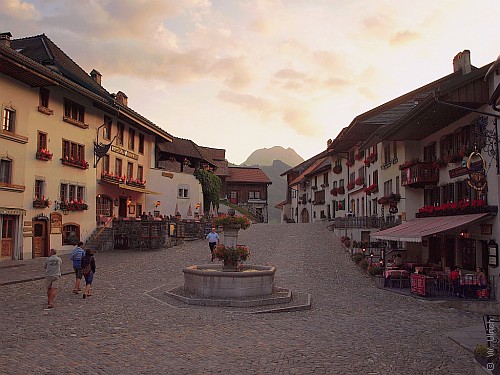
Leaving
Gruyères at nightfall
Gruyères,
or small can be great In
an old little book about the Canton of Fribourg, I find
the following thought about the secret charm of the region and its towns:
Greatness resides
not in physical dimensions but rather, in proportions and
relationships – relationships of men to nature, of people to
the city; for it is the human being which provides the measure
of things.
These
words were written in 1957 by Gonzague de Reynold, a Fribourg
aristocrate and writer, in Fribourg et le monde (Fribourg
and the World, 1957, my free rendering). It seems to me they
capture the soul of Gruyères as well as is possible in a sentence.
The secret may lie in what Gruyères is not, or as the
author explains:
How
can one love a big and densely populated city that has too many
houses but not enough architecture; a city whose heart one cannot
find again; a city that, being incessantly torn down and rebuilt,
has too much presence and not enough past? (G. de Reynold, Fribourg
et le monde, 1957, my free transl.)
So
much I take for granted: once you have discovered the
Pays de Gruyère and its heart, the castle and town of Gruyères,
you will want to come back and get more of this unexpected antidote
to the ubiquitous "too much" of soulless architecture
and growth that we encounter all around us, but by which Gruyères
definitely is not plagued.
Au
revoir!
Picture
data Digital
photograph taken on 10 September 2009, around 7:30 p.m., in
Gruyères, Switzerland. ISO 100, exposure mode
aperture priority, aperture f/5.6,
exposure time 1/320 seconds, exposure bias -0.30, focal length 42 mm (equivalent to 84 mm with a conventional 35 mm camera). Original resolution 3648
x 2736 pixels; current
resolution 700 x 525 pixels, compressed to 101 KB
(click to see larger picture of 1024 x 768 pixels, compressed to 212 KB).
|
For a hyperlinked overview of all issues
of "Ulrich's Bimonthly" and the previous "Picture of the
Month" series,
see the site map
|